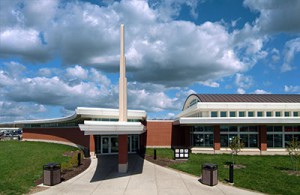 LOCATION:
LOCATION:
Milepost 20.8 – Westbound
Between Exit 13 and 25
County: Williams
How it got its name
FUEL SERVICES:
FOOD SERVICES:
 Burger King - (24 Hour)
Burger King - (24 Hour)
 Sbarro
Sbarro
 Starbucks
Starbucks
TRUCKERS LOUNGE
- Designated truckers lounge with easy access from the 112-space Commercial truck parking lot
- Separate restrooms & complimentary shower facilities
- Coin-operated washer & dryers
- Touch & Win Ohio Lottery EZ Play video gaming terminals
OTHER SERVICES
- 7-Eleven Convenience Store – Customers looking for on-the-go snacks, beverages, food and travel supplies can find them here
- Snack and beverage vending machines
- Travel Board InfoCenters and Turnpike Television (traffic alerts and weather information)
- ATM
- Ohio Lottery- 7-Eleven Convenience Store is the authorized Ohio Lottery retailer at this location
- E-ZPass – stop by the 7-Eleven Convenience Store at this location to pick up an E-ZPass transponder for your next trip (Passenger car customers only)
- RV Overnight Parking Area with electrical hookups, wastewater station, and potable water. Note: 10 (pull-through) RV parking spaces are available. The Ohio Turnpike RV lots can accommodate vehicles up to 40 feet in length.
HOW INDIAN MEADOW SERVICE PLAZA GOT ITS NAME
The early settlers of Williams County, Ohio, who had survived the precarious journey through the vast Black Swamp which covered most of northwestern Ohio, found just west of the swamp is a low, level prairie in which the Indians cultivated the soil and raised corn for food. This pleasant spot, on the banks of the St. Joseph River, near the present site of Edgerton, they called “Indian Meadow,” and the name has been preserved in the designation of the Indian MeadowService Plaza, which lies some miles northeast of the original Meadow.
The principal tribes which made their homes in this region and presumably shared in cultivating Indian Meadow were the Ottawa, Miami, Wyandot and Potawatomi Indians. Most of the region in which the indigenous people lived and hunted was a thick, swampy forest whose impenetrability chilled the homesteading ambitions of all but the hardiest settlers. Not until the forests had been cleared and the swamps had been drained was the cultivation of crops possible in most of this generally forbidding land. Through the ingenuity of the farmers of northwestern Ohio, who developed intricate and effective systems of drainage, the wilderness was transformed into an agricultural Eden.
When plans for building the Ohio Turnpike across the northwestern counties of Ohio were announced, many farmers feared at first that such an extensive project would disrupt the drainage systems on which their livelihood depends. These fears were overcome when, with the aid of federal, state and county extension and soil conservation experts, the Ohio Turnpike Commission formulated an agricultural drainage policy which provided engineering measures to preserve existing drainage systems and to permit their expansion in the years to follow.
Although Ohio is often spoken of as an industrial state, about 80 percent of its area, or 21 million acres, is in farmland, of which about 20 million acres are cultivated or pastured. In terms of cash income to farmers, Ohio ranks eighth among the states.
Corn, which was grown at Indian Meadow even before the arrival of the Europeans, is still one of the best-paying crops in Ohio, particularly in northwest Ohio. The summer traveler on the Ohio Turnpike passes between walls of growing corn for many miles. This area is indeed the eastern entrance to the great Corn Belt, which extends westward to Nebraska. In contrast to the primitive methods used at Indian Meadow, the planting, cultivation and harvesting of corn is now done largely by machinery. Ohio’s annual corn production is over 200,000,000 bushels, most of which is fed to dairy cattle and hogs.
Unlike the Native American farmers of Indian Meadow, modern Ohio farmers have learned to conserve the soil by rotating corn, wheat and clover; or corn, oats, wheat and grass. Most of the wheat grown in Ohio is the “soft red winter” variety. Some if it goes into general purpose flour for home use, but the greater the part provides pastry flour for commercial bakeries.
Grass and legumes are the principal crops in rotated acreage. In northwestern Ohio, some of the hay produced is sold; in the rest of Ohio most of it is fed on the farm in which it is grown.
In Ohio soybeans are an important crop. The rapid expansion of soybean acreage has been made possible by the combine harvester. This is also an oats-growing state, with Fulton County, through which the Ohio Turnpike passes to the east of the Indian Meadow Service Plaza, ranking among the state’s ten leading oats-growing counties.
Other crops which contribute in good measure to the Ohio farmer’s income are vegetables, fruit, greenhouse and nursery products, sugar beets and tobacco.
As sources of farm income in Ohio, dairying ranks first and hog-raising second. Poultry and beef cattle also provide considerable revenue. The nearness of large markets and the existence of a first class system of primary and farm-to-market highways have enabled the Ohio farmer to expand his markets and hence his acreage to the point where Ohio farms now produce nearly a billion dollars worth of crops, including fruit, a year. The Ohio Turnpike is now furnishing the farmer with a means of cutting still more time in transportation from farm to market. Farming in Ohio has made gigantic strides since the days of Indian Meadow.